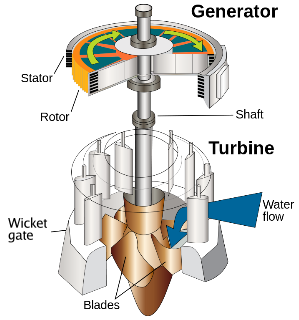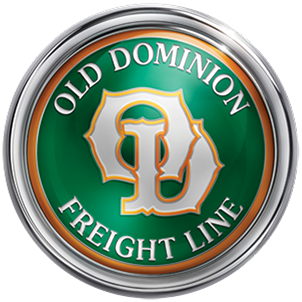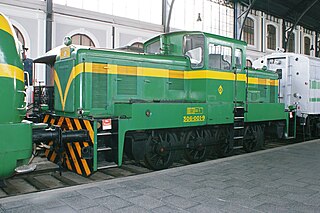
A Pelton wheel is an impulse-type water turbine invented by American inventor Lester Allan Pelton in the 1870s. The Pelton wheel extracts energy from the impulse of moving water, as opposed to water's dead weight like the traditional overshot water wheel. Many earlier variations of impulse turbines existed, but they were less efficient than Pelton's design. Water leaving those wheels typically still had high speed, carrying away much of the dynamic energy brought to the wheels. Pelton's paddle geometry was designed so that when the rim ran at half the speed of the water jet, the water left the wheel with very little speed; thus his design extracted almost all of the water's impulse energy—which allowed for a very efficient turbine.

A water turbine is a rotary machine that converts kinetic energy and potential energy of water into mechanical work.

A hybrid vehicle is one that uses two or more distinct types of power, such as submarines that use diesel when surfaced and batteries when submerged. Other means to store energy include pressurized fluid in hydraulic hybrids.

The modern combined harvester, or simply combine, is a versatile machine designed to efficiently harvest a variety of grain crops. The name derives from its combining four separate harvesting operations—reaping, threshing, gathering, and winnowing—into a single process. Among the crops harvested with a combine are wheat, rice, oats, rye, barley, corn (maize), sorghum, soybeans, flax (linseed), sunflowers and canola. The separated straw, left lying on the field, comprises the stems and any remaining leaves of the crop with limited nutrients left in it: the straw is then either chopped, spread on the field and ploughed back in or baled for bedding and limited-feed for livestock.

An automatic transmission is a multi-speed transmission used in motor vehicles that does not require any driver input to change gears under normal driving conditions. It typically includes a transmission, axle, and differential in one integrated assembly, thus technically becoming a transaxle.

A diesel locomotive is a type of railway locomotive in which the prime mover is a diesel engine. Several types of diesel locomotives have been developed, differing mainly in the means by which mechanical power is conveyed to the driving wheels.

A paper mill is a factory devoted to making paper from vegetable fibres such as wood pulp, old rags, and other ingredients. Prior to the invention and adoption of the Fourdrinier machine and other types of paper machine that use an endless belt, all paper in a paper mill was made by hand, one sheet at a time, by specialized laborers.

A transmission is a machine in a power transmission system, which provides controlled application of power. Often the term 5-speed transmission refers simply to the gearbox, that uses gears and gear trains to provide speed and torque conversions from a rotating power source to another device.

A continuously variable transmission (CVT) is an automatic transmission that can change seamlessly through a continuous range of gear ratios. This contrasts with other transmissions that provide a limited number of gear ratios in fixed steps. The flexibility of a CVT with suitable control may allow the engine to operate at a constant RPM while the vehicle moves at varying speeds.
A variable-pitch propeller or controllable-pitch propeller (CPP) is a type of propeller with blades that can be rotated around their long axis to change the blade pitch. Reversible propellers—those where the pitch can be set to negative values—can also create reverse thrust for braking or going backwards without the need to change the direction of shaft revolution.

The launched roller coaster is a modern form of roller coaster. A launched coaster initiates a ride with high amounts of acceleration via one or a series of linear induction motors (LIM), linear synchronous motors (LSM), catapults, tires, chains, or other mechanisms employing hydraulic or pneumatic power. This mode of acceleration powers many of the fastest rollercoasters in the world.

Hydraulic machines use liquid fluid power to perform work. Heavy construction vehicles are a common example. In this type of machine, hydraulic fluid is pumped to various hydraulic motors and hydraulic cylinders throughout the machine and becomes pressurized according to the resistance present. The fluid is controlled directly or automatically by control valves and distributed through hoses, tubes, or pipes.
In motor vehicles, a power steering system helps drivers steer the vehicle by augmenting steering effort needed to turn the steering wheel, making it easier for the vehicle to turn or maneuver.

Automated manual transmission (AMT), also known as a clutchless manual, denotes a type of multi-speed motor vehicle transmission system that is closely based on the mechanical design and internal build of a conventional manual transmission, and uses automation to operate either the clutch, and/or the gear shifting.

Hypersonic XLC was a roller coaster located at Kings Dominion in Doswell, Virginia. Hypersonic was built by S&S Worldwide, a company specializing in air-powered rides, and was the first compressed air launch coaster in the world. Hypersonic was S&S Worldwide's actual prototype for an air-launched coaster, called Thrust Air 2000.

Manchester's Hydraulic Power system was a public hydraulic power network supplying energy across the city of Manchester via a system of high-pressure water pipes from three pumping stations from 1894 until 1972. The system, which provided a cleaner and more compact alternative to steam engines, was used to power workshop machinery, lifts, cranes and a large number of cotton baling presses in warehouses as it was particularly useful for processes that required intermittent power. It was used to wind Manchester Town Hall clock, pump the organ at Manchester Cathedral and raise the safety curtain at Manchester Opera House in Quay Street. A large number of the lifts and baling presses that used the system had hydraulic packings manufactured by John Talent and Co.Ltd. who had a factory at Ashworth Street, just off the Bury New Rd. close to the Salford boundary.

The 50 calibre BL 8 inch gun Mark VIII was the main battery gun used on the Royal Navy's County-class heavy cruisers, in compliance with the Washington Naval Treaty of 1922. This treaty allowed ships of not more than 10,000 tons standard displacement and with guns no larger than 8 inches (203 mm) to be excluded from total tonnage limitations on a nation's capital ships. The 10,000 ton limit was a major factor in design decisions such as turrets and gun mountings. A similar gun formed the main battery of Spanish Canarias-class cruisers. In 1930, the Royal Navy adopted the BL 6 inch Mk XXIII naval gun as the standard cruiser main battery in preference to this 8-inch gun.

Meguro motorcycles were built by Meguro Manufacturing Co motorcycle works (目黒製作所), founded by Hobuji Murato and a high-ranking naval officer, Takaji Suzuki, in 1937. One of the first Japanese motorcycle companies, it became a partner of Kawasaki Heavy Industries Ltd, and was eventually absorbed. Named after a district of Tokyo, Meguro had its roots in Murato Iron Works, which was established in 1924. Meguro Seisakusho, which had once developed a copy of a Harley-Davidson V-twin, was established to design and build gearboxes for the nascent Japanese motorcycle industry. Abe Industries, which had once produced its own motorcycle, merged with Meguro in 1931. The brand is being revived by Kawasaki with a new K3 model to be introduced in Japan on February 1, 2021.

Old Dominion Freight Line, Inc. is an American less than truckload shipping (LTL) company. It offers regional, inter-regional and national LTL service. In addition to its core LTL services, the company offers logistics services including ground and air expedited transportation, supply chain consulting, transportation management, truckload brokerage, container delivery and warehousing, as well as household moving services. It contracts with freight forwarding services worldwide.

The Yorkshire Engine Company Taurus and Indus locomotives were two very similar lines of 0-8-0, diesel-hydraulic locomotives that weighed 58 tons and had a maximum speed of 36 mph (58 km/h). The two Rolls-Royce C8SFL diesel engines gave a total of 600 hp (450 kW). The transmission of the Taurus locomotives worked on a similar principle to that of the Fell diesel tested during the early 1950s. In this case, at low speeds only one engine was used, the second being engaged between 3.5 mph and 15 mph to enable haulage of 300 - 500 ton loads at speeds of up to 36 mph. The maximum speed with one engine was 12 mph (19 km/h) while the minimum speed with both engines was 3.5 mph (5.6 km/h). Both engines drove to a common torque converter and used a common throttle control with a separate lever being provided to engage the second engine as the need arose.



















